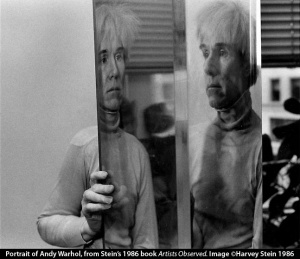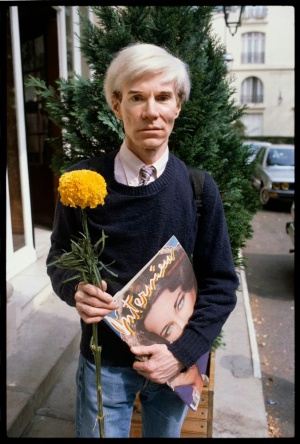Andy Warhol

Andy Warhol (August 6, 1928 – February 22, 1987) was an American artist, father of pop art mouvement. After a successful career as a commercial illustrator, Warhol became a renowned and sometimes controversial artist. Warhol's art encompassed many forms of media, including hand drawing, painting, printmaking, photography, silk screening, sculpture, film, and music. He was also a pioneer in computer-generated art using Amiga computers that were introduced in 1984, two years before his death. He founded Interview Magazine in 1969. The magazine features intimate conversations between some of the world's biggest celebrities, artists, musicians, and creative thinkers.
Biography
(from Klaus Honnef, Chronology in Andy Warhol, 1928-1987: Commerce Into Art, Taschen, 2000:94-95)
1928-1931. Born between these dates. Warhol himself claimed that his 1930 birth. He was born under the name Andrew Warhola in Forest City, Pennsylvania, the son of miner worker Ondrej Warhola and his wife Julia. In 1912 his father emigrated from former Czechoslovakia to US. Andrew had 2 brothers.
1945. Finishes high school.
1945-1949. Studies at Carnegie Institute of Tehnology, Pittsburg, as a working pupil. Meets Philip Pearlstein, a felow student. During the summer holidays he works in a department store.
1949. In June graduates as a Bachelor of Fine Arts. Moves to New York and lives in a apartment at St. Mark's Place, Lower East Side. Works as a commercial artist for Vogue magazine and Harper's Bazaar and produces his first advertising drawings for known shoe manufacturer I. Miller. In the same year he creates his original window-dressing for Bonwit Teller. Shortens his name to Andy Warhol.
1952. First solo exhibition at the Hugo Gallery in New York.
1953-1955. Designs the scenery for an off-Broadway theater group. Dyes his hair the straw color which until the day of his death was to be his iconic image all over the world. Together with his mother he moves into a house on Lexington Avenue.
1954. First group exhibition at the Loft Gallery, New York.
1956. First solo exhibition oh his drawings for the Boy Book at the Bodley Gallery exhibition of Golden Shoes on Madison Avenue. Goes on a world trip and is inspired mostly by the city of Florence (Italy). His drawings are included in the group exhibition Recent Drawings USA at the MoMA.
1957. Awarded for commercial artist from the Art Director's Club Medal.
1960. Creates
Gallery
- Polaroid portraits
- Andy Warhol Unseen Polaroids from 1970's - 1980's (1).jpg
Caroline, Princess of Monaco, 1983
- Andy Warhol Unseen Polaroids from 1970's - 1980's (2).jpg
Unidentified girl (Blue t-shirt with Teddy Bear), 9/1979
- Awesome Mick Jagger Polaroid Portraits by Andy Warhol.jpg
Mick Jagger, Polaroid Portrait
- Celebrity Portraits taken by Andy Warhol with his Polaroid Camera (2).jpg
Debbie Harry, 1980
- Celebrity Portraits taken by Andy Warhol with his Polaroid Camera (3).jpg
Diana Ross, 1981
- Celebrity Portraits taken by Andy Warhol with his Polaroid Camera (5).jpg
Dolly Parton, 1985
- Celebrity Portraits taken by Andy Warhol with his Polaroid Camera (12).jpg
Keith Haring, 1986
- Celebrity Portraits taken by Andy Warhol with his Polaroid Camera (19).jpg
Arnold Schwarzenegger, 1977
- Celebrity Portraits taken by Andy Warhol with his Polaroid Camera (21).jpg
John Lennon, 1971
- Celebrity Portraits taken by Andy Warhol with his Polaroid Camera (22).jpg
Tatum O'Neal, 1986
- Celebrity Portraits taken by Andy Warhol with his Polaroid Camera (25).jpg
Yoko Ono, 1971
- Andy Warhol - Self-Portrait in Drag, 1981 (2).jpg
Andy Warhol - Self-Portrait in Drag, 1981
- Andy Warhol - Self-Portrait in Drag, 1981 (3).jpg
Andy Warhol - Self-Portrait in Drag, 1981
- Andy Warhol - Self-Portrait in Drag, 1981 (4).jpg
Andy Warhol - Self-Portrait in Drag, 1981
- Warhol10a.jpg
Polaroid pictures taken by Andy Warhol. Clockwise from top left: Sean Lennon, Truman Capote, Evelyn Kuhn, William Burroughs, Martha Graham, Jimmy Carter. Photographs: Founding Collection, The Andy Warhol Museum, Pittsburgh © 2008 The Andy Warhol Foundation for the Visual Arts, Inc.
- Drawings for Kurt Benirschke, Vanishing animals, Springer-Verlag, 1986
- Gazelle.JPG
Gazelle
- Horse.JPG
Mongolian horse
Filmography
Andy Warhol made over 100 movies, short or long, from 1963 to late 1970s, mostly silent experimental films.
- Sleep, with John Giorno, 1963
- Kiss, 1963
- Screen Tests, features artists such as Marcel Duchamp, Bob Dylan, Salvador Dali, Dennis Hopper, and others, 1964
- Eat, with Robert Indiana, 1964
Legacy
The Andy Warhol Museum in his native city, Pittsburgh, Pennsylvania, holds an extensive permanent collection of art and archives. It is the largest museum in the United States dedicated to a single artist.
Literature
- Books by Warhol
- The Philosophy of Andy Warhol (From A to B & Back Again), written by Pat Hackett and Bob Colacello, New York: Harcourt Brace Jovanovich, 1975
- with Pat Hackett, Popism: The Warhol Sixties, New York: Harcourt Brace Jovanovich, 1980
- with Pat Hackett, The Andy Warhol Diaries, Grand Central Publishing, 1991
- Books about Warhol
- Victor Bockris, The Life and Death of Andy Warhol, New York: Bantam Books, 1989
- Klaus Honnef, Andy Warhol, 1928-1987: Commerce Into Art, Taschen, 2000
- Andy Warhol, edited by Annette Michelson, essays by Benjamin H.D. Buchloh, Thomas Crow, Hal Foster, Annette Michelson and Rosalind E. Krauss (October files, 2), The MIT Press, 2001
Links
- Warhol Digitally Paints Debbie Harry with the Amiga 1000 Computer (1985)
- Warhol's robot designed by Walt Disney animator Alvaro Villa
- http://www.ubu.com/sound/warhol.html
- http://www.ubu.com/film/warhol_cinema.html
- http://avantgardefilmindex.org/filmmakers/warhol-andy/
- http://en.wikipedia.org/wiki/Andy_Warhol
